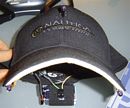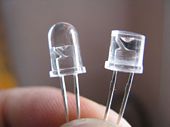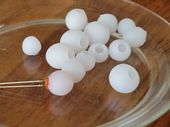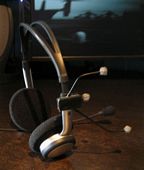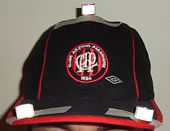Point model
To simplify the problem of optical motion tracking, bright points are used so they can be completely isolated from background light and then tracked using basic blob tracking. Blob tracking is more reliable, precise and efficient than complex image tracking, it can track well in a wider range of different lighting environments at full frame rate with minimal CPU usage.
All it takes is something as simple as a LED flashlight mounted to a cap or a piece of illuminated reflective material for two degrees of freedom (2DOF), which are also the most useful. Point models consisting of three points or more allow tracking in full six degrees of freedom (6DOF) in 3D space. Configurations include single point, three point clip, three point cap and four point cap. The four point model has fewer uncertain orientations but these can be easily avoided in three point models with the advantage of one less LED to power.
LED point model examples by FreeTrack users:
Points can be ordinary visible LEDs (preferably red) or ideally infrared LEDs which emit mostly invisible dim red light in the 720nm-1000nm wavelength range. LEDs with a smaller, more visible wavelength (850nm) are preferred if the camera's infrared-blocking filter is still in place, otherwise a larger, more infrared wavelength (950nm) will give better isolation (at least 880nm is required for the Wii Remote). The LED package should be 5mm or larger so that the resulting blob is sufficiently sized for tracking.
The LED viewing angle is important as head rotation with a fixed display can be up to 40 degrees in either direction. Most LEDs have a lens tip that focuses the light quite narrowly, this can be filed off to spread the light over a greater angle with a corresponding reduction in brightness. The angle can also be increased, and the blob size as well, by placing a light diffuser over the LEDs, such as a layer of glue or Blu-Tack, or a ball of packing foam or modelling clay. Wide angle LEDs are available without the lens like the popular SFH485P, an 880nm infrared LED with +-40 degrees half angle (80 degrees total).
LEDs can be powered by battery, transformer or USB.
Reflective point model examples by FreeTrack users:
Alternatively, points can be retroreflective tape or spheres and illuminated by lamps, preferably infrared so the light is invisible and not blinding. The tape should be curved so that the area illuminated is not too small at the extremes of yaw rotation. Webcams with built-in infrared LEDs are convenient USB powered lamps and cheaper ones that don't make good cameras could be purchased solely for this purpose. Be aware that powerful infrared lamps with a large number of LEDs, meant for lighting large areas, can be harmful to look at in close proximity for extended periods.
Updated by Kestrel Sep. 2011





